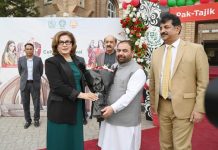ISLAMABAD: The nations, proud of its cultural heritage and history, endeavor for preserving the minute details for future generations in shape of museums as repositories for nations’ heritage of cultural heirlooms spreading over centuries. The cultural history of Pakistan is spanning over hundreds of years starting from subcontinent to the present-day Pakistan along the diverse and unique cultural heritage of all the four provinces including Gilgit-Baltistan and Azad Jammu & Kashmir. Islamabad being the symbol of federation and capital city of the country, has taken the responsibility to preserve and represent the peculiar traditional legacies of the entire country in shape of the museums. For this purpose, over the years, the federal capital has established four large museums that serve the appetite of those who are captivated by the rich culture of arts, music and literature. An official of the Department of Archaeology & Museums (DOAM) Abdul Ghafoor said that Islamabad museums has some historical objects and antiques as old as around 2 million years while most of them date back to 20th century till the British Raj. He said, “Islamabad museums preserve and display around 1300 antique objects from Gandhara and Indus Civilizations, Mohenjo-Daro, Harappa and ancient Indian civilization including Hindu, Buddhist and Mughal era.” The funding for the maintenance of museums under cultural heritage and archaeological departments comes from the federal government, he added. Pakistan Monument Museum (PMM), located in the heart of Islamabad, was built in 2010 on the west of Shakarparian Hills as a testimonial for all those heroes who lost their lives either during freedom movement or creation of Pakistan. Portraying the freedom struggle of Muslims of the sub-continent, birth of Pakistan and major achievements of the country, the monument constructed on the hills in shape of four tulip leaves with embossed sketches that narrate the story of freedom fighters of 1857. The PMM also has library, audio-visual archive and conference hall along with a sixty-two (62) seat capacity auditorium, known as Panorama Hall where documentaries regarding the struggles of our founding fathers are played for visitors. Heritage museum, Pakistan National Museum of Ethnology, popularly known as Heritage Museum, was established in 1982. The museum offers a wide range of cultural and historical statues and monuments related to Pakistan, South and East Asian regions. Museum starts with the long corridor that features mementoes and statues from Bloachistan, Sindh, Punjab, Khyber Pakhtunkhwa, Gilgit-Baltistan, Azad Jammu & Kashmir and then taking forward to souvenirs of Central Asian states. Pakistan Railways Heritage Museum also known as Golra Sharif Railway Museum, established in October, 2003 is the reminder of the British Raj era in the region. It is located in the southeast of Margallah Hills and east of Gandhara civilization, the ancient city of Taxila. This station was established in 1882 while it upgraded as junction in 1912. It is housed in three different halls to contain articles exhibiting history of railway over a period of more than 150 years. The articles include mechanical models, ancient signaling systems, communication tools and evolution of operational protocols that are chronologically displayed in the museum. Pakistan Museum of Natural History (PMNH), located in Shakarparian, Islamabad, was opened to public in 1986. The PMNH comprised of four main divisions and six galleries which houses more than 1.4 million specimens in categories of rocks, minerals, animals and plants, even prehistoric beasts. The Museum displays are detailed and varied, which requires at least two hours of exploring. Functioning under Ministry of Science & Technology (MoST), the Museum has four divisions: Botanical Sciences, Earth Sciences, Zoological Sciences and Public Services. The first three divisions are engaged in the collection and preservation of plants, fossils/minerals and animals resources of Pakistan while the latter is responsible for mass education and popularization of the natural history through various exhibits and dioramas.



